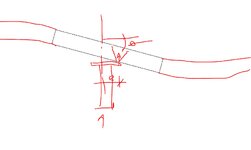Nick6781
Structural
- May 15, 2024
- 38
Need someone to validate my thoughts.
The diagrams on the left show a continuous slab with an idealized fixed joint at the interior column. The unbalanced moment Mu in the slab will be transferred to the top of the column. According to ACI 318-11 Section 11.11.7.1 (Transfer of Moment in Slab-Column Connections), part of the unbalanced moment is transferred through flexure, while the remainder is transferred through shear stress. This part is clear to me.
The diagrams on the right show the same continuous slab, but with a hinge at the interior column connection. This condition could arise in practice if the slab is supported by a slender steel post or an unreinforced concrete column, or a masonry pier. Since the slab within the critical shear perimeter does not bend about point O, there is no moment transfer at the joint. Additionally, the combined shear stress distribution along the critical shear perimeter should be relatively uniform. Given this, should we only check for pure punching shear in the scenarios I mentioned? Am I missing anything?

The diagrams on the left show a continuous slab with an idealized fixed joint at the interior column. The unbalanced moment Mu in the slab will be transferred to the top of the column. According to ACI 318-11 Section 11.11.7.1 (Transfer of Moment in Slab-Column Connections), part of the unbalanced moment is transferred through flexure, while the remainder is transferred through shear stress. This part is clear to me.
The diagrams on the right show the same continuous slab, but with a hinge at the interior column connection. This condition could arise in practice if the slab is supported by a slender steel post or an unreinforced concrete column, or a masonry pier. Since the slab within the critical shear perimeter does not bend about point O, there is no moment transfer at the joint. Additionally, the combined shear stress distribution along the critical shear perimeter should be relatively uniform. Given this, should we only check for pure punching shear in the scenarios I mentioned? Am I missing anything?


